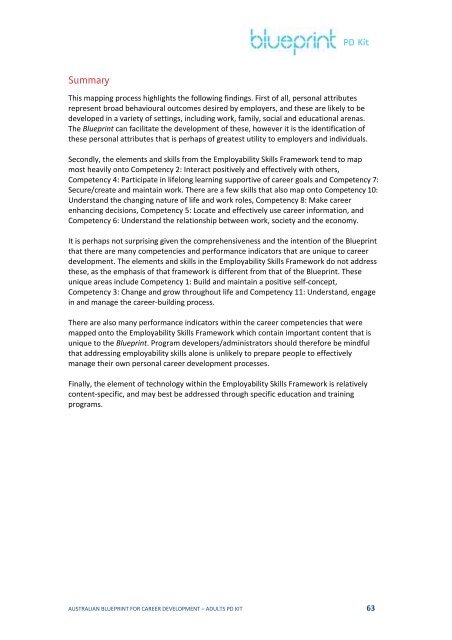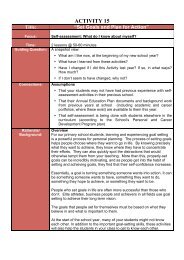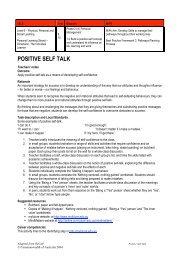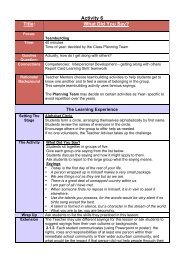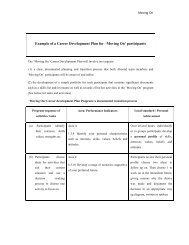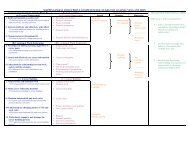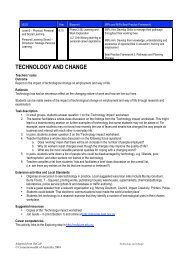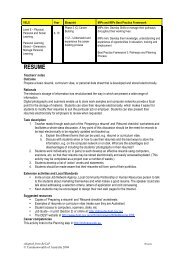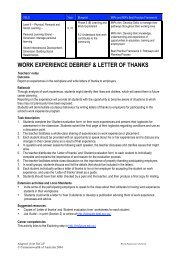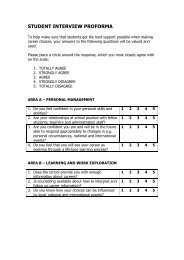Re-write of case studies - Blueprint - Australian Blueprint for Career ...
Re-write of case studies - Blueprint - Australian Blueprint for Career ...
Re-write of case studies - Blueprint - Australian Blueprint for Career ...
Create successful ePaper yourself
Turn your PDF publications into a flip-book with our unique Google optimized e-Paper software.
PD Kit<br />
Summary<br />
This mapping process highlights the following findings. First <strong>of</strong> all, personal attributes<br />
represent broad behavioural outcomes desired by employers, and these are likely to be<br />
developed in a variety <strong>of</strong> settings, including work, family, social and educational arenas.<br />
The <strong>Blueprint</strong> can facilitate the development <strong>of</strong> these, however it is the identification <strong>of</strong><br />
these personal attributes that is perhaps <strong>of</strong> greatest utility to employers and individuals.<br />
Secondly, the elements and skills from the Employability Skills Framework tend to map<br />
most heavily onto Competency 2: Interact positively and effectively with others,<br />
Competency 4: Participate in lifelong learning supportive <strong>of</strong> career goals and Competency 7:<br />
Secure/create and maintain work. There are a few skills that also map onto Competency 10:<br />
Understand the changing nature <strong>of</strong> life and work roles, Competency 8: Make career<br />
enhancing decisions, Competency 5: Locate and effectively use career in<strong>for</strong>mation, and<br />
Competency 6: Understand the relationship between work, society and the economy.<br />
It is perhaps not surprising given the comprehensiveness and the intention <strong>of</strong> the <strong>Blueprint</strong><br />
that there are many competencies and per<strong>for</strong>mance indicators that are unique to career<br />
development. The elements and skills in the Employability Skills Framework do not address<br />
these, as the emphasis <strong>of</strong> that framework is different from that <strong>of</strong> the <strong>Blueprint</strong>. These<br />
unique areas include Competency 1: Build and maintain a positive self-concept,<br />
Competency 3: Change and grow throughout life and Competency 11: Understand, engage<br />
in and manage the career-building process.<br />
There are also many per<strong>for</strong>mance indicators within the career competencies that were<br />
mapped onto the Employability Skills Framework which contain important content that is<br />
unique to the <strong>Blueprint</strong>. Program developers/administrators should there<strong>for</strong>e be mindful<br />
that addressing employability skills alone is unlikely to prepare people to effectively<br />
manage their own personal career development processes.<br />
Finally, the element <strong>of</strong> technology within the Employability Skills Framework is relatively<br />
content-specific, and may best be addressed through specific education and training<br />
programs.<br />
AUSTRALIAN BLUEPRINT FOR CAREER DEVELOPMENT – ADULTS PD KIT 63


